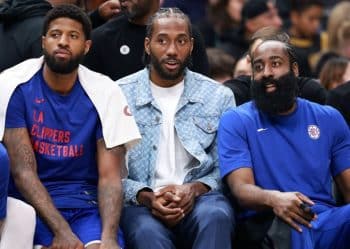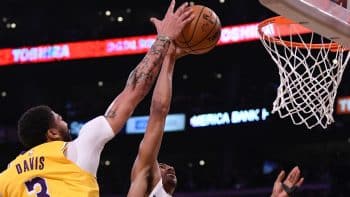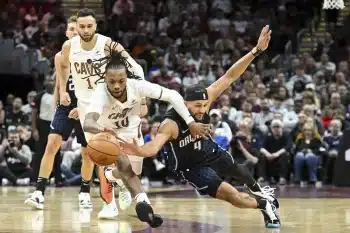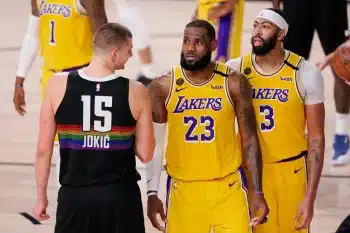NBA
Rest Assured, the 1-16 NBA Playoff Format Is Coming… Kinda

If there’s one thing Adam Silver has proven in his four years as the NBA’s Commissioner, it’s that he isn’t afraid to do things his way.
And if Silver has his way, the league will eventually figure out how it can implement a system that results in a more balanced playoff system. On Saturday, though, he revealed that it’s probably closer to a reality than many of us realize.
During his annual All-Star media address, Silver admitted that the league will “continue to look at” how they can reformat the playoffs to both ensure a better competitive balance throughout and pave the way for the league’s two best teams to meet up in the NBA Finals, even if both of those two teams happen to be in the same conference.
“You also would like to have a format where your two best teams are ultimately going to meet in the Finals,” the commissioner said on Saturday night.
“You could have a situation where the top two teams in the league are meeting in the conference finals or somewhere else. So we’re going to continue to look at that. It’s still my hope that we’re going to figure out ways.”
Since Silver took over the league, he’s been consistent in implementing dramatic changes to improve the overall quality of the game. Although Silver didn’t take over as the league’s commissioner until 2014, he was instrumental in getting the interested parties to buy into the notion that the “center” designation on the All-Star ballot was obsolete.
As a result, beginning with the 2013 All-Star Game, the Eastern and Western Conference teams have featured three “frontcourt” players, which essentially lumps centers in with forwards and eliminates the requirement that a center appear in the All-Star game. That wasn’t always the case.
From overhauling the league’s scheduling to reducing back-to-back games to implementing draft lottery reform, he clearly has his eyes open. On Silver’s watch, the league also eliminated the traditional All-Star format which featured the Eastern Conference versus the Western Conference, and it’s become clear that he simply gets it. Silver isn’t afraid to make revolutionary changes if he deems them to be in the overall best interest of the league.
At this point, everyone realizes that something needs to be done about the league’s current playoff system.
Last season, for example, the Western Conference first round playoff series featured the Houston Rockets and Oklahoma City Thunder squaring off against one another. Only one series—the Los Angeles Clippers versus Utah Jazz—went seven games.
Meanwhile, in the Eastern Conference, the first round series that were contested weren’t exactly compelling.
The Cleveland Cavaliers steamrolled the conference to the tune of a 12-1 run to their third consecutive trip to the NBA Finals. It wasn’t the first time that the public questioned the wisdom behind separating the playoff brackets by conference, but the dominance of the Cavs and LeBron James specifically (who is expected to win the Eastern Conference for the eighth consecutive time this season) has caused renewed scrutiny.
The most common solution offered to this point has been to simply take the 16 best teams across the league, irrespective of conference, and conduct the playoffs as normal.
From afar, this solution seems simple enough, but the obvious concerns are twofold.
First, if the Celtics and Clippers, for example, were pitted against one another in a first round series, the travel would be considerable. Private charter flight or not, traveling is taxing, and the prospect of having to make five cross-country trips over the course of a two-week span would certainly leave the winner of such a series at a competitive disadvantage against the opponents they would face in subsequent rounds, especially if the future opponent enjoyed a playoff series that was contested within close proximity.
Atlanta to New Orleans, for example, is less than a one-hour flight.
Aside from the concerns about geographic proximity, the other obvious issue is competitive balancing of the schedule, which seems to be an easier issue to fix.
Using the Pelicans as an example, of the 82 games they play, 30 are played against the other conference—in this case, the Eastern Conference. The other 52 games would all be played within the conference. If playoff seedings were going to be done on a simple 1-16 basis, the scheduling would have to be realigned in a way to essentially pit all teams against one another evenly. It wouldn’t be fair for a team like the Celtics to be judged on the same standard as the Pelicans if the Celtics faced inferior teams more often.
On Saturday night, Silver revealed that the league’s brass has been thinking about this and is trying to find a solution, and in doing so, he may have tipped his hand.
* * * * * *
As a multinational conglomerate, the NBA values the inclusion of as many markets as possible. Wanting to improve the overall quality of the product, though, there are interests that may not align fully.
What’s obvious with this year’s All-Star game is that the NBA has found a way to balance the two.
Rather than eliminating the conference designations altogether and simply choosing the “best” 24 players to be in the All-Star game, the league still chose All-Stars based on their conference, but then distributed them within the pool to allow for better competition.
That’s exactly what Silver revealed the NBA is considering doing with the playoffs. It makes perfect sense, and it’s probably just a matter of time before it’s implemented.
A report from ESPN notes that the idea that the league is kicking around would essentially do exactly what the league did with the All-Star selections with the playoff teams: choose the best from each conference, then disburse them in a way that allows for competitive balance.
The proposal would have the league’s teams compete as they normally do and would still feature the top eight teams from each conference getting into the playoffs.
Once the teams are qualified, however, they would be re-seeded on a 1-16 basis and crossmatched, on that basis.
It’s not perfect, but compromises never are. The travel issues would still persist, but the league would accomplish two goals: the less dominant conference wouldn’t be underrepresented and discouraged from competing, but the two best teams would still be on opposite ends of the bracket.
An NBA playoffs that featured 11 or 12 teams from the Western Conference would be a ratings nightmare for the league. Eastern Conference cities are less likely to stay up past midnight during the week to watch playoff games, and less competitive markets would frown at the prospect of having to compete against the other conference for a playoff spot. For many small market teams, the millions of dollars generated from a single playoff game often has a significant impact on the team’s operations, so there would naturally be discord.
This system would at least eliminate that contention.
On the positive side, it would allow for the Rockets and Warriors, for example, to meet in the NBA Finals. In both the NFL and MLB, geography hasn’t been a determining factor on which teams battle for the league’s championship.
Why does it have to be in the NBA?
* * * * * *
With the league having begun regular season play earlier this season, at the All-Star break, most teams have played about 57 games. A lot can change over the final 25 games of the season, but if the seeds were frozen today and the league took the top eight teams from each conference and then crossmatched them, the Los Angeles Clippers would be the team that got the short end o the stick.
Although the Clippers have the 16th best record in the league, they would be the ninth-seeded Western Conference team and would thus be eliminated from postseason contention by the Miami HEAT. The HEAT have the 17th best record in the league but are the eighth-best team in the Eastern Conference, so to preserve the conference weight, the HEAT would win out.
This is what the seedings and matchups would look like…
(1) Houston Rockets versus (16) Miami HEAT
(2) Golden State Warriors versus (15) New Orleans Pelicans
(3) Toronto Raptors versus (14) Philadelphia 76ers
(4) Boston Celtics versus (13) Portland Trail Blazers
(5) Cleveland Cavaliers versus (12) Denver Nuggets
(6) San Antonio Spurs versus (11) Oklahoma City Thunder
(7) Minnesota Timberwolves versus (10) Milwaukee Bucks
(8) Washington Wizards versus (9) Indiana Pacers
Here, the Celtics would face the nightmarish scenario of having to travel to and from Portland for their playoff series, while virtually every other series would feature much more friendly travel (especially the Spurs-Thunder and Raptors-Sixers).
The Cavs would have a very tough road to the Finals, having to beat the Nuggets, Celtics and Rockets if the seeds held. The Celtics would have a similarly tough road, as they’d have to get past the Blazers, Cavs and Rockets.
At the end of the day, the Rockets and Warriors would be aligned in such a way as to avoid one another until the championship, but each of the two would face daunting competition. The Rockets would have to go through the HEAT, Wizards and Celtics, while the Warriors would have to face the Pelicans, Timberwolves and Raptors—again, assuming the seeds held.
It would be a benefit to all observers.
One of the unintended consequences of implementing this system would be to make every single game count. If the Celtics were able to move up to the second seed, for example, their road to the Finals, in theory, could become much much easier, comparatively speaking.
The end result would be less resting of players during the course of the season and certainly less instances in which star players take the final week of the regular season off in order to be fresh for the postseason.
Everyone wins.
No, there’s no perfect solution, but just as the league has found a clever way to serve multiple interests as it relates to the All-Star game’s competitiveness, Silver has revealed that the league is at least considering following suit with the playoffs.
Best bet?
It’s only a matter of time before we see it actually see it happen.











